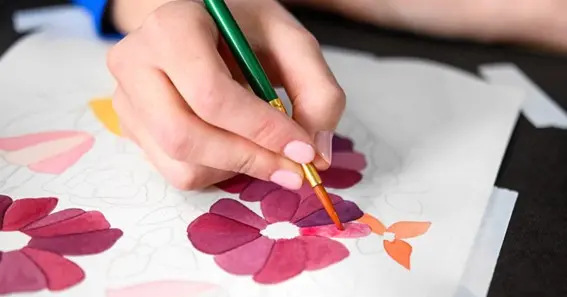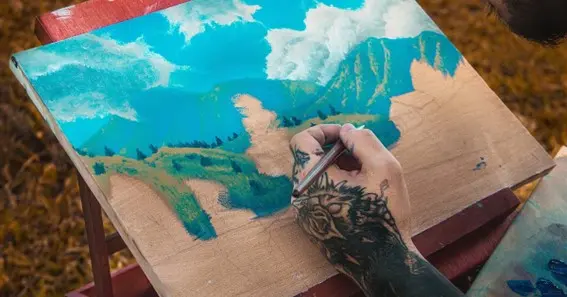What is gouache paint? Gouache is a versatile, opaque paint with a matte finish, combining properties of watercolor and acrylic, and can be reactivated with water even after drying. Various methods exist to use gouache paint, a medium between watercolor and acrylic. Artists who appreciate broad washes and minute details love its thick, matte finish. Gouache paint has unique properties and a rich history, making it ideal for many painting endeavors. Learn the complexities of gouache to improve your painting, regardless of your experience. In this article, we discuss about what is gouache paint and more about it.
What Is Gouache Paint?
Gouache is a versatile, opaque paint with a matte finish, combining properties of watercolour and acrylic, and can be reactivated with water even after drying. Water-based gouache paint is opaque and matte. We mix artificial or natural colors, gum Arabic or yellow dextrin for binding, and chalk for the body. Gouache covers well, unlike watercolor, which shows colors. This lets artists add colors without revealing others. Gouache works well for extensive, bright backgrounds and small, detailed pictures. Add water to the dried gouache to make it work again. These make changes and touch-ups easy. Due to its unique properties and ease of application, gouache is ideal for animators, designers, and fine painters.
Things You Ought To Know About Gouache Paint

Gouache paint is unique due to its opaque, matte finish. Watercolor and acrylic combine in their distinct features. Understanding its qualities can improve your art and yield new outcomes. Due to its history and versatility, artists can utilize gouache in many ways. As we already discuss what is gouache paint, now explore this comprehensive guide to gouache paint will help artists maximize this versatile medium.
Context And Past
Gouache has a rich past that extends back to the Middle Ages. At first, it was used to illuminate manuscripts. Because it was opaque, scribes could add bright details to scribbled texts. European painters liked gouache by the 18th century and used it to paint landscapes and portraits. Commercial artists and designers used gouache in the 20th century because it dried quickly and had bright colors that were great for design and advertising. Gouache is still a favorite among artists because it can be used in many ways and has a unique finish.
Synthesizing
You get a different result when you mix gouache paint with other paints. Usually, it has these parts:
- Colors: The color derives from these natural or artificial sources.
- Binding agents: Gum Arabic or yellow dextrin usually binds pigment specks.
- Chalk: I added occasionally to make the paint opaque and matte.
Mixed, they make a paint thicker than watercolor but thinner than acrylic. It’s easy to use and covers all the layers below it.
Coverage And Darkness

One of the things that makes gouache unique is its invisibility. Unlike watercolors, which are known for their transparency and ability to build up color through layers, gouache can cover previous layers entirely. This makes it particularly useful for artists who want to make changes or add highlights and details over dark backgrounds. Because gouache is opaque, it can create bright, bold colors that stand out on any surface.
Reactivation
Going back to work with water is one of the unique things about gouache. Artists can mix or lift the color with water even after the color dries. This reactivation feature lets you add layers or make changes without affecting the paint below. Gouache is flexible and forgiving because artists can keep their tools wet.
Methodology
After read what is gouache paint , now know how use gouache in several different ways, such as:
- Cleans: You can dilute gouache with water to make soft, clear splashes, the same way you can dilute watercolor.
- Constructing: Because it is opaque, gouache is excellent for adding colors on top of each other without getting them mixed up.
- Dry Brushing: Using a dry brush, artists can achieve detailed effects and fine details.
- Blending: It’s easy to blend colors on the palette or right on the drawing surface to smooth the changes.
These methods make gouache suitable for many types of art, from detailed drawings to extensive, emotional works.
Surface Compatibility
With its ability to work with many surfaces, gouache is a flexible choice for artists. The following are some popular surfaces:
- Paper: Heavy watercolor paper is best because it can take many washes and layers.
- A canvas: You can use gouache on linen, although the paint might stick better on a surface with greater roughness.
Adding And Mixing
After read about what is gouache paint, you should know gouache is easy to blend, allowing artists to create a number of distinct colors and hues. It is easy to mix on the palette, and painters can keep their combined colors wet and ready to use since they can bring them back to life with water. You can also blend colors on the drawing surface, making the color changes look smooth.
Conclusion
Gouache paint is helpful for artists because of its long history and unique qualities. This combines watercolor and acrylic best. The paint’s matte sheen, reactivation, and opacity make it excellent for numerous artistic techniques and surfaces. Whether an illustrator or hobbyist, gouache allows you freedom and colorful effects that can improve your work. As you explore the realm of gouache, you’ll uncover unlimited choices for artistic expression. In above we discuss about what is gouache paint and explore more about it.
Whether you’re a beginner or a professional, gouache paint offers a unique and creative way to bring your artwork to life.
FAQ
What Media Accepts Gouache?
Gouache works on paper, canvas, and drawing boards, but heavy watercolor paper is most favored.
Can Water Revive Gouache?
Water can revive dried gouache so that you can edit and work on it again.
Are Gouache And Acrylic Similar?
Gouache has a firm finish like acrylic, yet it’s water-based and reusable, unlike acrylic.
How Can I Protect My Gouache Drawings?
Flatten and protect gouache artwork from sunshine and dampness. Protective sprays may also help sustain them.
Can You Paint With Gouache?
Gouache is helpful for various art forms because it can create fine details and bold colors.
Is Gouache Paint Beginner-Friendly?
Yes, its reworkable nature and ability to layer make it a great choice for beginners exploring opaque painting techniques.
What Are The Best Brushes For Gouache?
Synthetic brushes work best, offering control for detailed work while holding water and pigment well.
Check out this insightful post what-is-a-speed-trap
Sources:
https://en.wikipedia.org/wiki/Gouache
https://fearlessbrush.com/2023/03/17/what-is-gouache-answering-your-gouache-faqs/










